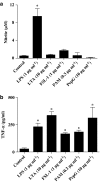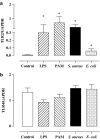Differential effects of Gram-positive versus Gram-negative bacteria on NOSII and TNFalpha in macrophages: role of TLRs in synergy between the two
- PMID: 16783405
- PMCID: PMC1752017
- DOI: 10.1038/sj.bjp.0706815
Differential effects of Gram-positive versus Gram-negative bacteria on NOSII and TNFalpha in macrophages: role of TLRs in synergy between the two
Abstract
1. Gram-negative and Gram-positive bacteria are sensed by Toll-like receptor (TLR)4 and TLR2, respectively. TLR4 recruits MyD88 and TRIF, whereas TLR2 recruits MyD88 without TRIF. NOSII and TNFalpha are central genes in innate immunity and are thought to be differentially regulated by the MyD88 versus TRIF signalling pathways. Here, we have used Gram-positive Staphylococcus aureus, Gram-negative Escherichia coli and highly selective TLR ligands to establish the precise relationship between TLR2, TLR1, TLR6 and TLR4 for NOSII versus TNFalpha induction. 2. In murine macrophages at 24 h, E. coli or LPS (TLR4) induced NO and TNFalpha release. In contrast, S. aureus (TLR2/TLR1/TLR6) or Pam(3)CSK4 (TLR2/TLR1), or FSL-1 and LTA (TLR2/TLR6) induced TNFalpha without an effect on NO. 3. At later time points (48-72 h), S. aureus induced NO release. The ability of S. aureus, but not E. coli or LPS, to induce NO release was inhibited by anti-TNFalpha-binding antibodies. 4. At 24 h, LPS synergised with TLR2 ligands to induce NO release and NOSII protein expression. LPS also induced the expression of TLR2 gene expression without affecting levels of TLR4. 5. Using cells from TLR2(-/-) or TLR4(-/-) mice, the ability of LPS to synergise with S. aureus or Pam(3)CSK4 was found to be dependent on both TLR2 and TLR4. 6. These observations are the first to clearly delineate the role of separately activating TLR2 and TLR4 in the induction of NOSII and TNFalpha genes compared with their coinduction when both receptor pathways are activated.
Figures









References
-
- ANANDARAJAH J., FLEET M.R., WALTERS M.J., BELCHER P.E., SRISKANDAN S., MITCHELL J.A. Gram positive and Gram negative bacteria synergise to cause nitric oxide synthase induction in murine macrophages. Br. J. Pharmcol. 2003;140:5P.
-
- BELCHER P.E., EVANS T.W., SRISKANDAN S., MITCHELL J.A. Gram-positive Staphylococcus aureus contrasts with Gram-negative Escherichia coli in the induction of tumour factor-alpha and nitric oxide from macrophages. Br. J. Anaesthesia. 2003;90:540P–541P.
-
- BEUTLER E., GELBART T., WEST C. Synergy between TLR2 and TLR4: a safety mechanism. Blood Cells Mol. Dis. 2001;27:728–730. - PubMed
-
- BRUN-BUISSON C., DOYON F., CARLET J. Bacteremia and severe sepsis in adults: a multicenter prospective survey in ICUs and wards of 24 hospitals. French Bacteremia-Sepsis Study Group. Am. J. Respir. Crit. Care Med. 1996;154:617. - PubMed
Publication types
MeSH terms
Substances
LinkOut - more resources
Full Text Sources
Other Literature Sources
Miscellaneous

